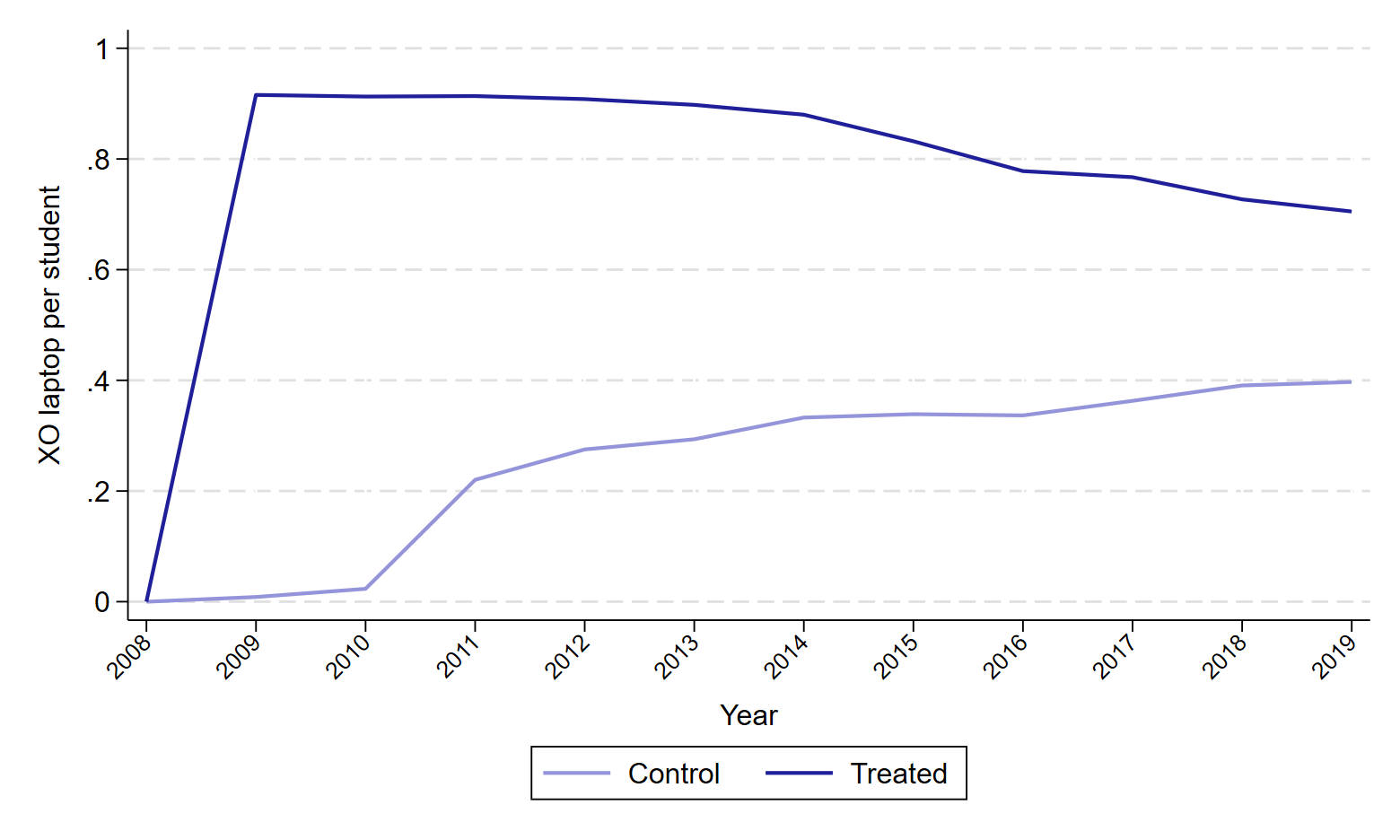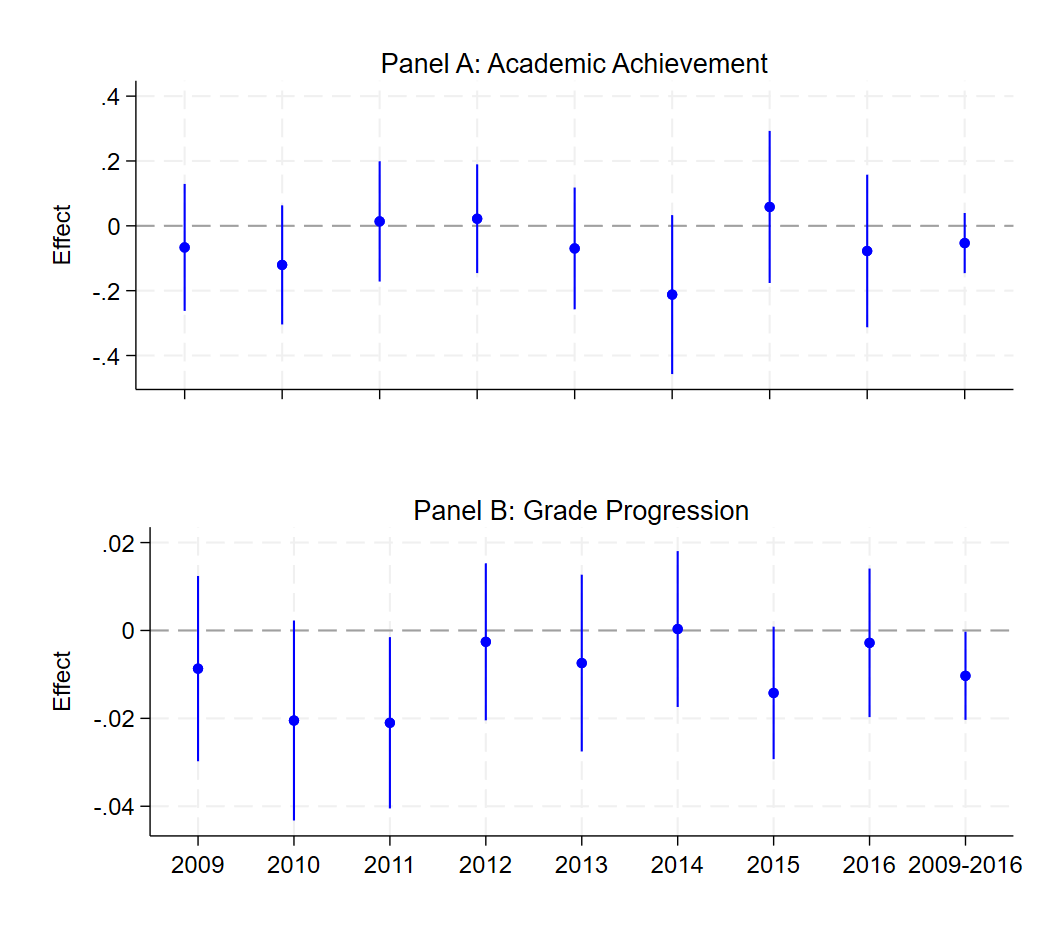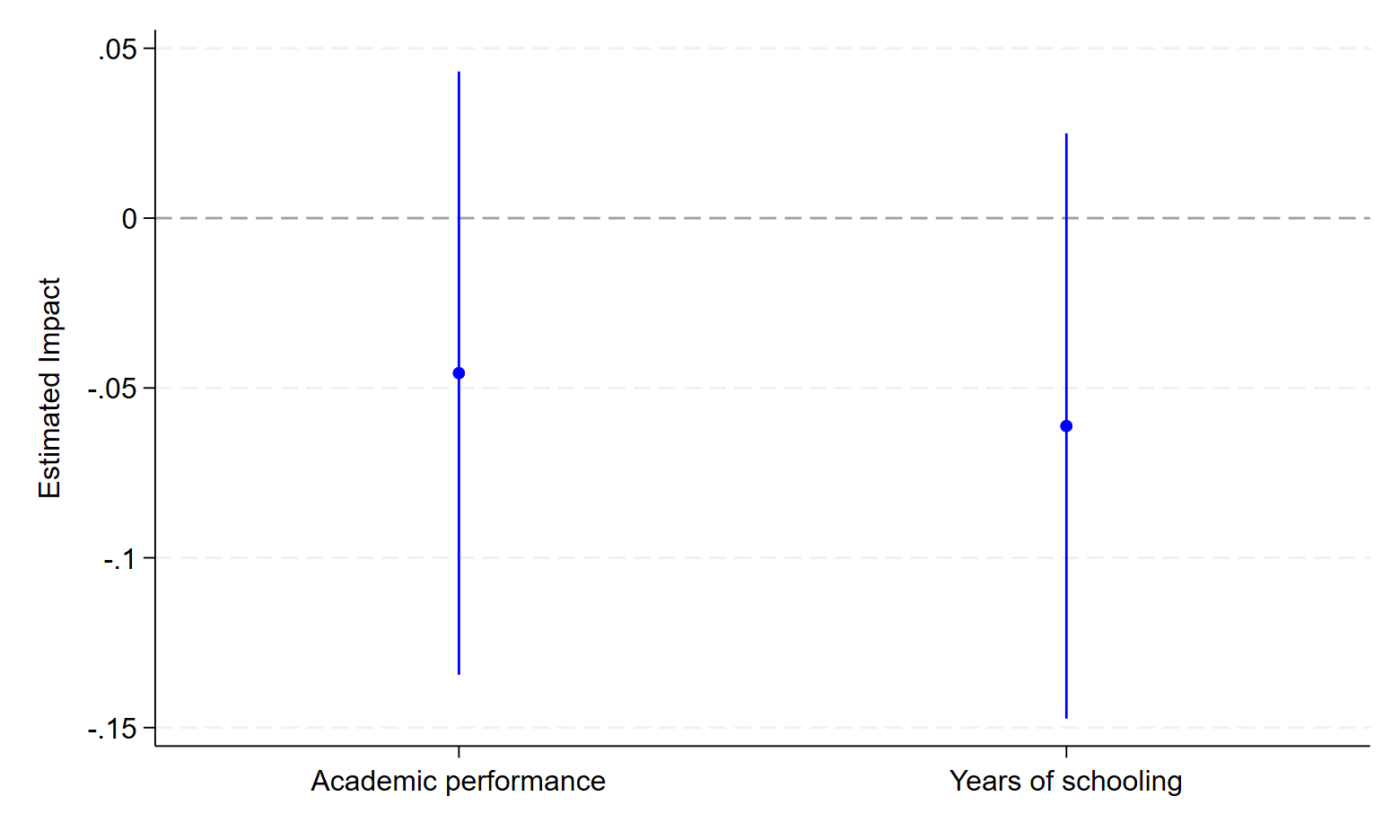
Long-term research on the One Laptop per Child programme reveals that providing laptops to students did not have a positive impact on educational outcomes, likely driven by lack of effects on cognitive skills and limited classroom adoption.
Developing countries have made large investments in expanding access to technology with the aim of improving children’s educational outcomes. Notwithstanding these substantial public and private investments, the evidence on their educational impacts has been ambiguous with a mix of positive effects (Muralidharan et al. 2019, Araya et al. 2019), null effects (Beuermann et al. 2015, Piper et al. 2016), and even negative effects (Linden 2008, Malamud and Pop-Eleches 2011).[1] However, with a few notable exceptions (Lakdawala et al. 2023, Yanguas 2020) most of the evidence is based on short-term estimates.
One highly publicised initiative that provided personal laptops to students in developing countries was the One Laptop per Child (OLPC) programme, which was implemented in over 40 countries. A large-scale experimental evaluation of the OLPC programme in Peru found no effects on academic achievement or enrolment in primary school after 15 months of programme implementation (Cristia et al. 2017). Here, we report on an experimental study that builds on this earlier work by examining the long-term effects of the OLPC programme in Peru (Cueto et al. 2024). To do this, we utilised a range of administrative and survey data to follow a new sample of students in 531 schools over 10 years.
Despite the absence of impacts on short-term academic achievement, expanding access to technology in schools could generate impacts on longer-term outcomes along two separate dimensions. On the one hand, there may be long-term effects on schools if teachers and principals need time to learn how to use technology effectively for pedagogical purposes.[2] On the other hand, there could be long-term effects on students as they progress through the educational system. Greater exposure to computers could lead to changes in students’ attitudes, behaviours, and a broad range of skills with larger effects on later educational outcomes. Thus, in this study, we examine the long-term effects of expanding school access to technology on both the academic performance of schools over time and students’ educational trajectories as they progress from primary to tertiary education.
Studying the impact of giving laptops to students
We focused on 531 rural primary schools that were randomised into 296 treatment schools and 235 control schools. Treatment schools were assigned to participate in the OLPC programme which provided students with personal laptops (called ‘XO laptops’) starting in 2009. These low-cost durable laptops were specifically designed for learning and came loaded with about 200 e-books and 39 applications.[3] In principle, students were allowed to take their laptops home, with about a fifth doing so in practice.
Using administrative data, Figure 1 shows that the programme increased the ratio of XO laptops to students in treatment schools from 0 to almost 1 by the end of 2009. Starting in 2011, some laptops were also distributed to schools in the control group so that the average ratio of XO laptops per student in these schools eventually reached 0.4 by 2019. There was also a decline in the ratio for treatment schools over time. Still, the marked difference in access to laptops between treatment and control schools remained.
Figure 1: XO Laptops per student over time

Laptops did not improve academic achievement in the long run
We first analysed the effect of the OLPC programme on schools’ academic achievement from 2009 to 2016 using data from annual second grade national exams in mathematics and reading. These results, shown in Panel A of Figure 2 below, indicate that there are insignificant effects on academic achievement (averaged across math and reading) without a clear pattern of differences in the effects over time. Pooling the data across all years, we estimate negative but insignificant effects on achievement, allowing us to rule out positive statistically significant effects larger than 0.05 and 0.03 standard deviations in mathematics and reading, respectively. Thus, there is little evidence to suggest that the OLPC programme improved school academic performance over time.
Figure 2: Effects for schools over time

We also estimated the effect of the OLPC programme on the fraction of primary students that advanced to the next grade between 2009 to 2016 using data from the annual school censuses. These results, shown in Panel B of Figure 2, are almost uniformly negative but usually insignificant. The pooled estimate shows a negative effect of 1.0 percentage point on grade progression, suggesting there may be some negative consequences of introducing 1-to-1 computers into the classroom.[4]
Laptops had no positive impact on student educational trajectories
We then assessed the effect of the OLPC programme on educational trajectories as students progressed through the school system. We obtained data from fourth and eighth grade national exams, from fifth and sixth grade tests that we administered in a subset of schools, as well as longitudinal administrative data on grade progression from primary to tertiary education. To summarise the results and address concerns related to multiple hypothesis testing, we constructed one measure that averaged all the exams and tests (‘academic performance’) and one measure that calculated average completed years of schooling (‘years of schooling’) for all cohorts through 2019. The estimated impacts on these two measures are shown in Figure 3 below.
Figure 3: Effects on student educational trajectories

We observe that the estimated impacts on academic performance and years of schooling are both negative and insignificant. There is no evidence that the OLPC programme improved educational outcomes of students over time.
Why did laptops have limited effects on educational outcomes?
Why did the OLPC programme not improve academic achievement or educational attainment? To address this question, we examined survey data that we collected from a subset of 140 schools in 2013. On the one hand, we estimated that teachers in treatment schools were 35 percentage points more likely to report receiving training in the use of XO laptops than teachers in control schools (with a mean of 28 percent). On the other hand, there were no significant impacts on the digital skills of teachers in their use of XO laptops, PC computers, or the internet. Furthermore, our results indicated that the OLPC programme generated only a relatively small increase in laptop and computer use in the classroom, as reported by teachers.
Turning to our student surveys, we document that the programme increased the use of XO laptops at home on the day prior to the survey by 20 percentage points. Consistent with this, we find large positive effects of 0.4 standard deviations on their digital skills in using XO laptops. However, we do not find any positive effects on an index of cognitive skills based on the Raven’s Progressive Matrices test, verbal fluency, and coding tests. Thus, the absence of positive impacts on academic achievement and educational attainment may be due to the relatively limited adoption of the XO laptops in schools for academic purposes and the small effects on students’ intermediate outcomes beyond digital skills.
Implications for future research on technology adoption in schools
With continued interest in increasing access to computers and internet among governments in developing countries, it is important to extend the existing evidence on the short-term effects to longer-term evaluations. Our study examining the long-term impacts of the OLPC programme in Peru indicates no positive effects on schools over time or student educational trajectories. The increasing access to technological resources at schools and at home makes it crucial to better understand how to best use these resources to improve educational outcomes. Looking forward, we expect future research to explore how recent advances in artificial intelligence may introduce opportunities to leverage technology in innovative ways to improve the delivery of educational services at low cost and large scale.
References
Araya, R, E Arias Ortiz, N L Bottan, and J P Cristia (forthcoming), “Does gamification in education work? Experimental evidence from Chile,” Economics of Education Review.
Beuermann, D W, J Cristia, S Cueto, O Malamud, and Y Cruz Aguayo (2015), “One Laptop per Child at home: Short-term impacts from a randomized experiment in Peru,” American Economic Journal: Applied Economics, 7(2): 53–80.
Cristia, J, P Ibarraran, S Cueto, A Santiago, and E Severin (2017), “Technology and child development: Evidence from the One Laptop per Child Program,” American Economic Journal: Applied Economics, 9(3): 295–320.
Cueto, S, D W Beuermann, J Cristia, O Malamud, and F Pardo (2024), “Laptops in the long-run: Evidence from the One Laptop per Child program in rural Peru,” Unpublished manuscript.
Lakdawala, L K, E Nakasone, and K Kho (2023), “Dynamic impacts of school-based internet access on student learning: Evidence from Peruvian public primary schools,” American Economic Journal: Economic Policy, 15(4): 222–254.
Linden, L (2008), “Complement or substitute? The effect of technology on student achievement in India,” Unpublished manuscript.
Malamud, O, and C Pop-Eleches (2011), “Home computer use and the development of human capital,” The Quarterly Journal of Economics, 126(2): 987–1027.
Muralidharan, K, A Singh, and A J Ganimian (2019), “Disrupting education? Experimental evidence on technology-aided instruction in India,” American Economic Review, 109(4): 1426–1460.
Piper, B, S S Zuilkowski, D Kwayumba, and C Strigel (2016), “Does technology improve reading outcomes? Comparing the effectiveness and cost-effectiveness of ICT interventions for early grade reading in Kenya,” International Journal of Educational Development, 49: 204–214.
Yanguas, M L (2020), “Technology and educational choices: Evidence from a One Laptop per Child program,” Economics of Education Review, 76: 101984.
[1] These studies encompass different types of policies and programmes, from computer-aided instruction to providing access to computers in schools and at home, and from range of different countries (Chile, India, Kenya, Peru, and Romania).
[2] This is the argument in Lakdawala et al. (2023), which documents limited impacts of internet access on schools after the first year, but growing and larger effects of internet access over time.
[3] Note that most teachers in the treatment group also received a one week 40-hour training that focused on how to operate the laptops and use them for pedagogical purposes.
[4] This estimate is significant at the 5% level based on its individual p-value, but just barely significant at the 10% level when accounting for multiple hypothesis testing with the academic achievement.





